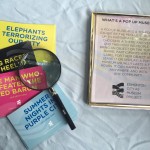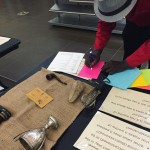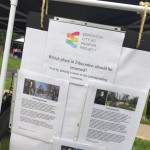In the latest blog post, EHC’s Traveling Exhibit Interpreter Alexandra Mackay shares what she has learned after a summer of connecting with Edmontonians through pop-up exhibits at the Night Market and various Edmonton Public Library locations.
—
With 30 exhibits over the last 4 months, the Edmonton City as Museum Project‘s summer pop-ups have been an enlightening journey. As my job as ECAMP’s summer popper-upper comes to a close, I wanted to share how the over 1,000 participants have educated me in the field of pop-up museums.
#1
The first thing I learned—almost immediately—was that “shifting perspectives” is not a practical goal.
If you set up a museum to engage people who approach with the intention of changing their attitude about a topic, you will probably fail. Or get yelled at. Perspective is a deep and highly personal system, a system that no museum educator can be held responsible for rewiring. Even disregarding complexity, perspective is highly subjective and being in the business of changing what others think sometimes borders ‘propaganda’ and ‘brainwashing’. Instead, the responsibility of the pop-up museum in approaching controversial topics is to inform, provide opportunities for practicing critical thinking, and empathy.
#2
This lesson reinforced that neutrality is a necessity.
People come to the pop-up (and any museum for that matter) with an entire life’s worth of memories, beliefs and values; the best way to respect their individuality is to skip the words endowed with even the subtlest positive or negative value and get right to facts.
A pop-up is a catalyst for considering how they relate to the world around them, rather than an instruction manual. It’s key to allow people to express their informed and independent opinions. Yet ‘informed’ is subjective and people who are already set on what they believe to be true cannot be convinced otherwise. My task was to find and provide accessibility to the most accurate information I can. Speaking of which…
#3
I learned that I am not a museum interpreter.
The public is the interpreter, understanding and assigning meaning to the information I provide. With the most objective language possible, my job was to provide information only, without creating any type of narrative around the subject. It was the job of those who participate to create their own narrative. And they did.
Then I experienced shared historical authority in its natural environment – people actively contributing their thoughts and feelings about history and their place in it.
Seeing history in museums does not often reflect the viewpoint of the present-day average Joe, however pop-ups in which the person can contribute their two cents make for an interesting myriad of interpretations surrounding history and contemporary issues.
#4
When people embrace this sense of ownership over the information, they begin to make it clear how they want to interact.
People express this directly or through body language, some more subtle than others. General preferences are also reflected through the success of each section of engagement. Most people were excited about questions that let them share their personal history and most overlooked the activities that required more extensive processing of historical information. However, they were more willing when they were informed of how the information connected to their lives. People want to learn about history when they can see a direct link to contemporary experience.
#5
Perhaps the most important take-away was the appreciation I acquired for museums tackling the elephantine task of unabridged engagement (and doing so successfully).
Communicating with an audience made up of incredibly diverse individuals is unpredictable, immensely challenging and very rewarding. From scathing lectures about what kind of a naïve person would believe this or that information or point of view to praise of the pop-up method for creating an opportunity for souls to seek mutual understanding, the people I met didn’t just build the exhibit, they taught me everything I know about pop-up museums.



